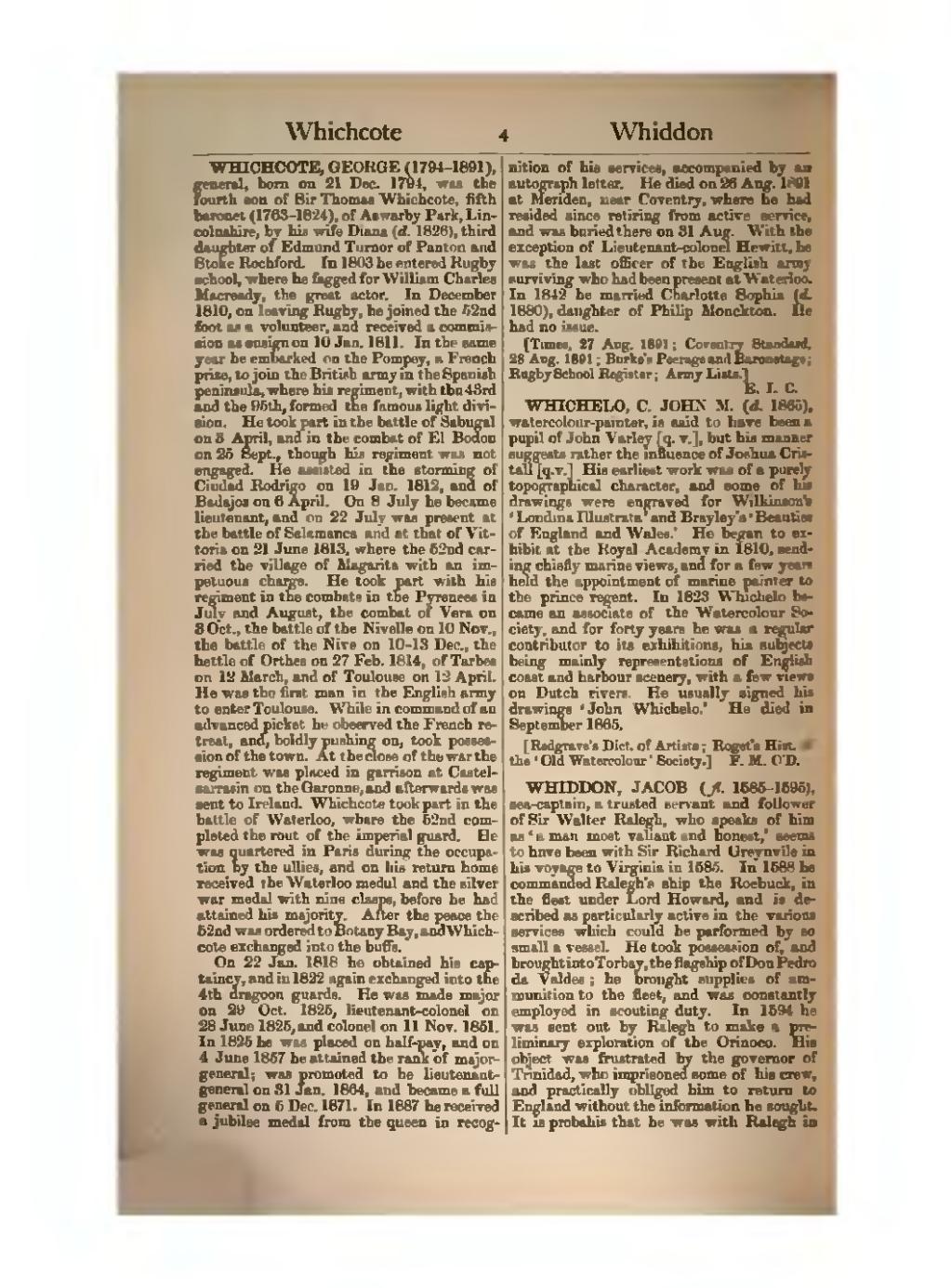WHICHCOTE, GEORGE (1794–1891), general, born on 21 Dec. 1794, was the fourth son of Sir Thomas Whichcote, fifth baronet (1763–1824), of Aswarby Park, Lincolnshire, by his wife Diana (d. 1826), third daughter of Edmund Turnor of Panton and Stoke Rochford. In 1803 he entered Rugby school, where he fagged for William Charles Macready, the great actor. In December 1810, on leaving Rugby, he joined the 52nd foot as a volunteer, and received a commission as ensign on 10 Jan. 1811. In the same year he embarked on the Pompey, a French prize, to join the British army in the Spanish peninsula, where his regiment, with the 43rd and the 95th, formed the famous light division. He took part in the battle of Sabugal on 3 April, and in the combat of El Bodon on 25 Sept., though his regiment was not engaged. He assisted in the storming of Ciudad Rodrigo on 19 Jan. 1812, and of Badajoz on 6 April. On 8 July he became lieutenant, and on 22 July was present at the battle of Salamanca and at that of Vittoria on 21 June 1813, where the 52nd carried the village of Magarita with an impetuous charge. He took part with his regiment in the combats in the Pyrenees in July and August, the combat of Vera on 3 Oct., the battle of the Nivelle on 10 Nov., the battle of the Nive on 10–13 Dec., the battle of Orthes on 27 Feb. 1814, of Tarbes on 12 March, and of Toulouse on 12 April. He was the first man in the English army to enter Toulouse. While in command of an advanced picket he observed the French retreat, and, boldly pushing on, took possession of the town. At the close of the war the regiment was placed in garrison at Castelsarrasin on the Garonne, and afterwards was sent to Ireland. Whichcote took part in the battle of Waterloo, where the 52nd completed the rout of the imperial guard. He was quartered in Paris during the occupation by the allies, and on his return home received the Waterloo medal and the silver war medal with nine clasps, before he had attained his majority. After the peace the 52nd was ordered to Botany Bay, and Whichcote exchanged into the buffs.
On 22 Jan. 1818 he obtained his captaincy, and in 1822 again exchanged into the 4th dragoon guards. He was made major on 29 Oct. 1825, lieutenant-colonel on 28 June 1838, and colonel on 11 Nov. 1851. In 1825 he was placed on half-pay, and on 4 June 1857 he attained the rank of major-general; was promoted to be lieutenant-general on 31 Jan. 1864, and became a full general on 5 Dec. 1871. In 1887 he received a jubilee medal from the queen in recognition of his services, accompanied by an autograph letter. He died on 26 Aug. 1891 at Meriden, near Coventry, where he had resided since retiring from active service, and was buried there on 31 Aug. With the exception of Lieutenant-colonel Hewitt, he was the last officer of the English army surviving who had been present at Waterloo. In 1842 he married Charlotte Sophia (d. 1880), daughter of Philip Monckton. He had no issue.
[Times, 27 Aug. 1891; Coventry Standard, 28 Aug. 1891; Burke's Peerage and Baronetage; Rugby School Register; Army Lists.]
WHICHELO, C. JOHN M. (d. 1865), watercolour-painter, is said to have been a pupil of John Varley [q. v.], but his manner suggests rather the influence of Joshua Cristall [q. v.] His earliest work was of a purely topographical character, and some of his drawings were engraved for Wilkinson's ‘Londina Illustrata’ and Brayley's ‘Beauties of England and Wales.’ He began to exhibit at the Royal Academy in 1810, sending chiefly marine views, and for a few years held the appointment of marine painter to the prince regent. In 1823 Whichelo became an associate of the Watercolour Society, and for forty years he was a regular contributor to its exhibitions, his subjects being mainly representations of English coast and harbour scenery, with a few views on Dutch rivers. He usually signed his drawings ‘John Whichelo.’ He died in September 1865.
[Redgrave's Dict. of Artists; Roget's Hist. of the ‘Old Watercolour’ Society.]
WHIDDON, JACOB (fl. 1585–1595), sea-captain, a trusted servant and follower of Sir Walter Ralegh, who speaks of him as ‘a man most valiant and honest,’ seems to have been with Sir Richard Greynvile in his voyage to Virginia in 1585. In 1588 he commanded Ralegh's ship the Roebuck, in the fleet under Lord Howard, and is described as particularly active in the various services which could be performed by so small a vessel. He took possession of, and brought into Torbay, the flagship of Don Pedro de Valdes; he brought supplies of ammunition to the fleet, and was constantly employed in scouting duty. In 1594 he was sent out by Ralegh to make a preliminary exploration of the Orinoco. His object was frustrated by the governor of Trinidad, who imprisoned some of his crew, and practically obliged him to return to England without the information he sought. It is probable that he was with Ralegh in
